|
From the Director: The Surveys We Count On
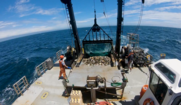
Each year, the Northeast Fisheries Science Center conducts multiple ecosystem and fisheries surveys at sea to understand how fish stocks and the marine ecosystem are changing over time. In this short video, go behind the scenes on our bottom trawl, sea scallop, and ecosystems monitoring surveys. Combined, these surveys provide the information scientists and managers need to manage our fisheries responsibly. These surveys also represent some of the longest marine data collection programs in the world, providing vital information to understanding climate change in the Northeast and globally.
Jon Hare, Center Director
|
Going Low to Reduce Sea Turtle Bycatch
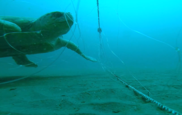
Working with fishermen across the East Coast, Northeast Fisheries Science Center researchers tested a new fishing gear design that reduces the chance of catching sea turtles in gillnets. Luckily, they had underwater cameras to see how it works! This video highlights a study testing a low profile gillnet that was shown to reduce sea turtle bycatch by 68%.
|
Why did the Northern Shrimp Population Collapse?
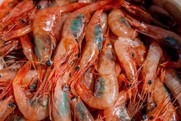
A recent study by scientists at the Northeast Fisheries Science Center and Maine Department of Marine Resources found that warming ocean temperatures and increased predation by squid are linked to the collapse of northern shrimp in the Gulf of Maine. Despite a fishing moratorium since 2013, the northern shrimp population has not recovered and the fishery remains closed. This study provides further evidence that changing species interactions will have major impacts as ecosystems reorganize due to climate change.
|
Eyes Underwater: How Fish Use Oyster Aquaculture Gear

Researchers at our Milford Lab have been using commercially available underwater video cameras to watch fish around oyster cages at shellfish farms. But what about species that are difficult to capture on camera? They combined the video approach with eDNA sampling techniques to detect more species. With colleagues at Rutgers University, they have started to build a more robust picture of how oyster cages can provide important habitat for a remarkable number of species.
|
Squid Processors Lend a Hand to Increase Data on a Short-Lived Species
Feeding Fish with Pride at Woods Whole Science Aquarium
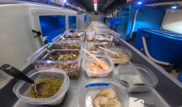
Preparing food for the animals at the nation’s oldest public marine aquarium is a gooey and fun process, but watching the fish eat may be the best part of all! Watch this video to see inside our Woods Hole Science Aquarium, learn how our staff prepares meals for the wide assortment of fish we hold, and best of all, watch a big feed.
|
2021 IN FISH! Students Celebrate National Hispanic Heritage Month
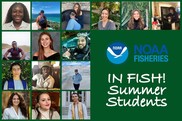
National Hispanic Heritage Month honors the histories, cultures, and contributions of those whose ancestors came from Spain, Mexico, the Caribbean, and Central and South America. To celebrate, we asked a few of our 2021 IN FISH! students who identify as Hispanic to share a little about their internship experience and what National Hispanic Heritage Month means to them. Meet 2021 IN FISH! students Robert Dellinger and Matteo Torres as they talk about their summer internship experience and what National Hispanic Month means to them.
|
2021 Northeast Summer Ecosystem Monitoring Cruise Completed
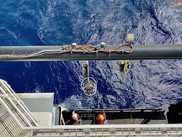
Researchers returned to sea for the second ecosystem monitoring (EcoMon) cruise of 2021. Scientists and crew aboard the NOAA Ship Pisces sampled at 149 stations. They achieved near-complete coverage of the survey area, from north of Delaware Bay through the Gulf of Maine. Together, the core measurements conducted by our EcoMon cruises help researchers understand and predict changes in the Northeast shelf ecosystem and its fisheries. Researchers are scheduled to sail on the next EcoMon survey in October aboard the Pisces.
|
The Little-Known History of the Narragansett Lab Research Aquarium
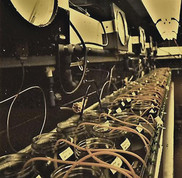
When the Narragansett Laboratory was originally dedicated in October 1966, it was part of the U.S. Department of the Interior’s Bureau of Sportfish and Wildlife. In 1970 it came under NOAA Fisheries as part of the Northeast Fisheries Science Center. One prominent feature of the early Narragansett Lab was a large research marine aquarium facility. In the fall of 1968, the aquarium sea-water system was turned on for the first time. Under the leadership of Connie R. Arnold and later Geoff Lawrence, the aquarium became a world-class facility where most fishes of the North Atlantic could be spawned and reared.
|
The Monitoring Decade: Learning About the Future from the Past
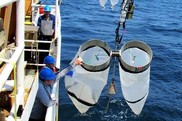
The Marine Resources Monitoring, Assessment and Prediction Program, or more easily referred to as MARMAP, was the longest-running ecosystem monitoring program of its time. The “MARMAP Decade” ran from 1977 through 1988, when the program collected biological and environmental information from periodic surveys of northeastern U.S. continental shelf waters. It was largely the brainchild of Kenneth Sherman, then a fisheries biologist at the Northeast Fisheries Science Center. The program integrated field data on seasonal and annual variability with fine-scale process-oriented field studies and laboratory research. The data collected by this survey still informs our science and data collection processes today.
|
What Makes a Bird a Seabird?
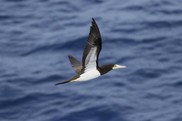
If you’ve spent any amount of time near the ocean, you’ve likely heard the word “seabird.” After all, any bird that associates with salty water is a seabird, right? Well, not quite—there’s no concrete definition of what makes a bird a seabird. But there are a few characteristics that ornithologists (bird scientists) and bird watchers alike use to define them.
|
Training in Collaborative Data Science
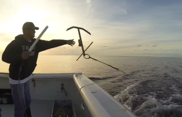
Starting at the end of September and continuing over 8 weeks, NOAA Fisheries researchers in the Greater Atlantic Region are connecting with a diverse group of academic labs through an Openscapes Champions cohort program that is focused on projects related to fishery dependent data. This work involves developing open science skills (such as a familiarity with GitHub), building connections within teams, and bringing researchers with a common purpose together to share resources.
|
|
|
Upcoming Events
Oct 1-31 Ocean Fun Days at the NOAA Fisheries James J. Howard Lab, Sandy Hook, NJ
Oct 14 One NOAA Science Seminar Series: Shannon Meseck on Ocean Acidification
Oct 22 Sea Scallop Research Set Aside (2022/2023 ) Proposals Due
Oct 26-27 Haddock Working Group Meeting
Nov 1 Atlantic Salmon Ecosystem Forum Abstracts Due
Nov 1 NOAA’s Community Resilience Education Grant Opportunity
|
|
|
|